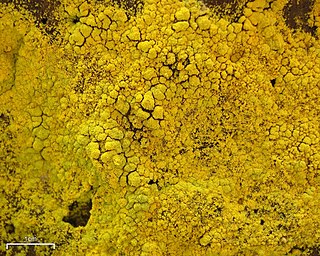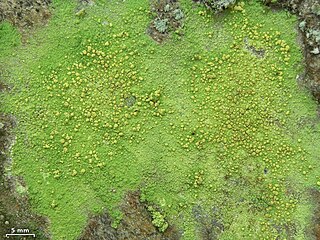
A lichen is a composite organism that arises from algae or cyanobacteria living among filaments of multiple fungi species in a mutualistic relationship. Lichens have properties different from those of their component organisms. They come in many colors, sizes, and forms and are sometimes plant-like, but are not plants. They may have tiny, leafless branches (fruticose); flat leaf-like structures (foliose); grow crust-like, adhering tightly to a surface (substrate) like a thick coat of paint (crustose); have a powder-like appearance (leprose); or other growth forms.

In botany, a cortex is an outer layer of a stem or root in a vascular plant, lying below the epidermis but outside of the vascular bundles. The cortex is composed mostly of large thin-walled parenchyma cells of the ground tissue system and shows little to no structural differentiation. The outer cortical cells often acquire irregularly thickened cell walls, and are called collenchyma cells.

Crustose is a habit of some types of algae and lichens in which the organism grows tightly appressed to a substrate, forming a biological layer. Crustose adheres very closely to the substrates at all points. Crustose is found on rocks and tree bark. Some species of marine algae of the Rhodophyta, in particular members of the order Corallinales, family Corallinaceae, subfamily Melobesioideae with cell walls containing calcium carbonate grow to great depths in the intertidal zone, forming crusts on various substrates. The substrate can be rocks throughout the intertidal zone, or, as in the case of the Corallinales, reef-building corals, and other living organisms including plants, such as mangroves and animals such as shelled molluscs. The coralline red algae are major members of coral reef communities, cementing the corals together with their crusts. Among the brown algae, the order Ralfsiales comprises two families of crustose algae.

Chrysothrix candelaris, commonly known as the mustard powder lichen or gold dust lichen, is a species of lichen in the family Chrysotrichaceae. It typically grows on tree bark. It does not show ascocarps or other reproductive structures, belonging to the group commonly known as the 'Fungi or lichens imperfecti' in the UK.

Acarospora is a genus of lichenized fungi in the family Acarosporaceae. Most species in the genus are crustose lichens that grow on rocks in open and arid places all over the world. They may look like a cobblestone road or cracked up old paint, and are commonly called cobblestone lichens or cracked lichens,. They usually grow on rock, but some grow on soil (terricolous) or on other lichens. Some species in the genus are fungi that live as parasites on other lichens. Acarospora is a widely distributed genus, with about 128 species according to a 2008 estimate.

Psilolechia is a genus of four species of crustose lichens. It is the only member of Psilolechiaceae, a family that was created in 2014 to contain this genus.
Lichens of the Sierra Nevada have been little studied. A lichen is a composite organism consisting of a fungus and a photosynthetic partner growing together in a symbiotic relationship.

A fruticose lichen is a form of lichen fungi that is characterized by a coral-like shrubby or bushy growth structure. It is formed from a symbiotic relationship of a photobiont such as green algae or less commonly cyanobacteria and one, two or more mycobionts. Fruticose lichens are not a monophyletic and holophyletic lineage, but is a form encountered in many classes. Fruticose lichens have a complex vegetation structure, and are characterized by an ascending, bushy or pendulous appearance. As with other lichens, many fruticose lichens can endure high degrees of desiccation. They grow slowly and often occur in habitats such as on tree barks, on rock surfaces and on soils in the Arctic and mountain regions.

Crustose lichens form a crust that strongly adheres to the substrate, making separation from the substrate impossible without destruction. The basic structure of crustose lichens consists of a cortex layer, an algal layer, and a medulla. The upper cortex layer is differentiated and is usually pigmented. The algal layer lies beneath the cortex. The medulla fastens the lichen to the substrate and is made up of fungal hyphae. The surface of crustose lichens is characterized by branching cracks that periodically close in response to climatic variations such as alternate wetting and drying regimes.

Foliose lichen is one of the morphological classes of lichens, which are complex organisms that arise from the symbiotic relationship between fungi and a photosynthetic partner, typically algae. This partnership allows lichen to live in diverse climates that can range from cold, dry mountains to wet, warm valleys. Lichens develop quite slowly with recorded growth rates of 0.01–27mm/year depending on the species. Their lifespan averages between 30 and 60 years.

Lichens are grouped by common lichen growth forms. There are a wide range of growth forms (morphology). These groupings may not be consistent with lichen taxonomy, since lichens with similar growth forms are not necessarily related by ancestry. Groups based on growth may overlap and have borderline cases. A species usually has the same overall growth form wherever it is found, but not always.

Lichen morphology includes lichen growth forms used to group lichens by "vegetative" thallus types, and forms of "non-vegetative" reproductive parts. Some lichen thalli have the aspect of leaves ; others cover the substrate like a crust, others such as the genus Ramalina adopt shrubby forms, and there are gelatinous lichens such as the genus Collema.
Terete is a term in botany used to describe a cross section that is circular, or like a distorted circle, with a single surface wrapping around it. This is usually contrasted with cross-sections that are flattened, with a distinct upper surface that is different from the lower surface. The cross-section of a branch in a tree is somewhat round, so the branch is terete. The cross section of a normal leaf has an upper surface, and a lower surface, so the leaf is not terete. However, the fleshy leaves of succulents are sometimes terete. Fruticose lichens are terete, with a roughly circular cross section and a single wrap-around skin-like surface called the cortex, compared to foliose lichens and crustose lichens, which have a flattened cross section with an upper surface that is distinct from the lower surface.

Aspicilia cinera is a gray to almost white, 1.5 – 15 cm wide, crustose areolate lichen with large apothecia that mostly grows on rock in the mountains. It grows in variable forms, from having a continuous surface to being areolate. It grows in Eurasia, and North America on siliceous rock, schist or igneous rock in habitats exposed to sunlight, also rarely on calciferous rock. It is common in Arizona, and rare in California and Baja California at elevations of 1,700 to 3,300 metres.

In lichens, rhizines are multicellular root-like structures, arising mostly from the lower surface. A lichen with rhizines is termed rhizinate, while a lichen lacking rhizines is termed erhizinate. Rhizines serve only to anchor the lichen to their substrate; they do not absorb nutrients as do plant roots. Characteristics of the rhizines are used to identify lichens, for example: whether they are dense or sparse, whether they are uniformly distributed or clumped in specific areas, and whether they are straight or branched. Only foliose lichens may possess rhizines, not crustose or fruticose lichens, which lack a lower cortex.
Lepraria salazinica is a species of rock-dwelling, leprose lichen in the family Stereocaulaceae. It is found in the eastern United States.

Ochrolechia africana, commonly known as the frosty saucer lichen, is a species of crustose and corticolous (bark-dwelling) lichen in the family Ochrolechiaceae. It is a widely distributed species, found in tropical and subtropical areas of southern Africa, Asia, Australia, North America, and South America. The lichen is characterized by the presence of a white "frosty" or powdery apothecia.
Chrysothrix bergeri is a species of crustose lichen in the family Chrysotrichaceae. It is found in the southeastern United States and the Caribbean, where it grows as a bright yellow, powdery crust on the bark and wood of mostly hardwoods.
Lepraria santosii is a species of crustose lichen in the family Stereocaulaceae. It occurs in Tenerife, in the Canary Islands.

The following outline provides an overview of and topical guide to lichens.













